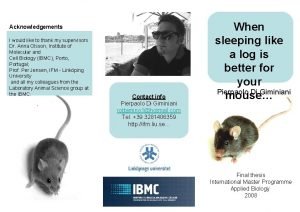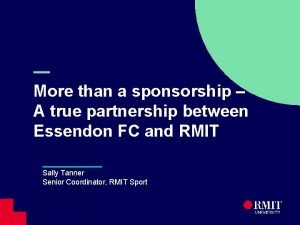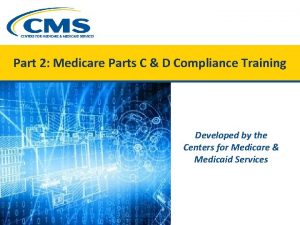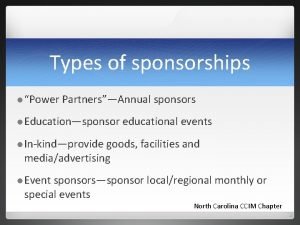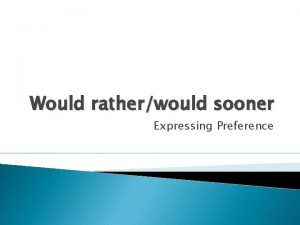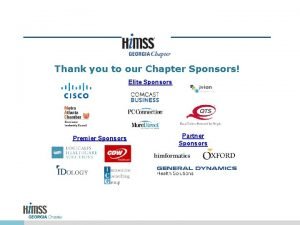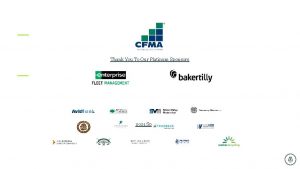Sponsors INSOL Europe would like to thank the












































- Slides: 44

Sponsors INSOL Europe would like to thank the following conference sponsor for their generous support: www. tmpartner. de INSOL Europe would also like to thank the following organisation for their support: Consiglio Nazionale dei Dottori Commercialisti e degli Esperti Contabili www. cndcec. it

Discussion on Article 5 (Rights in rem governed by the law of their location) & Article 7 (Reservation of title) Moderator: Daniel Fritz, HERMANN RWS, Frankfurt am Main Prof. Michael Veder, Radboud University Nijmegen, Business & Law Research Centre and RESOR, Amsterdam Dr. Andreas Piekenbrock, Ruprecht-Karls-Universität Heidelberg

Secured Creditors: In Search of Balance Prof. Michael Veder Radboud University Nijmegen Business & Law Research Centre And RESOR Amsterdam

Discussion on Article 5 (Rights in rem governed by the law of their location) Dr. Andreas Piekenbrock Ruprecht-Karls-Universität Heidelberg

Topics on Art. 5 EIR 1. The legislator’s choices 2. Case studies 3. Discussion 4. Conclusion

1. The legislator’s choices a) Substantive Restriction Rule: “The opening of insolvency proceedings in one Member State (“Member State A”) has no effect on the creditors’ or third parties’ rights in rem on the debtor’s collaterals situated in other Member States (“Member State B”). ”

1. The legislator’s choices Understanding of Art. 7(1) EIR by E. C. J. 10 September 2009 – Case C -292/08 (German Graphics) [2009] ECR I-8421 para. 35: Article 7(1) “constitutes a substantive rule intended to protect the seller with respect to assets which are situated outside the Member State of opening of insolvency proceedings. ”

1. The legislator’s choices Current understanding of Art. 5(1) EIR put into question by E. C. J. 5 July 2012 – Case C‑ 527/10 (ERSTE Bank Hungary Nyrt), para. 42: “… Article 5(1) EIR must be understood as a provision which, derogating from the rule of the law of the State of the opening of proceedings, allows the law of the Member State on whose territory the asset concerned is situated to be applied to the right in rem of a creditor or a third party over certain assets belonging to the debtor. ”

1. The legislator’s choices b) Choice of Law Rule (as drafted by INSOL Europe): “The effects of insolvency proceedings on the rights in rem of creditors or third parties in respect of tangible or intangible, moveable or immoveable assets […] belonging to the debtor which are situated within the territory of another Member State at the time of the opening of proceedings shall be governed solely by the law of the Member State within which the assets are situated. ”

1. The legislator’s choices c) Opposition Rule (similar to Art. 13 EIR): - Art. 4(2)(n) is added, reading as follows: “the effects of insolvency proceedings on rights in rem on assets situated in other Member States. ” - Art. 5(1) is amended as follows: “Article 4(2)(n) shall not apply as far as a creditor or a third party provides proof that the substantial effects on rights in rem under the law applicable to the main proceedings are incompatible with the law of the Member State within which the assets are situated. ”

2. Case Studies Case 1 Facts: The debtor, a retail company residing in Germany, has assigned its claims against its German and Austrian clients to a German creditor as a collateral and informed the clients of the transaction. Insolvency Proceedings are opened in Germany.

2. Case Studies Case 1 European Legal Framework - The assignment of all claims is governed by German civil law (Art. 4(1)(a), 14(2)(3) Rome I-Reg. ). - The claims are situated in Germany and Austria respectively according to the third parties’ COMI (Art. 2(g) EIR).

2. Case Studies Case 1 National Legal Framework in Germany: - Civil law: The clients have to pay to the creditor (§ 362(1) BGB) - Insolvency Law: The insolvency administrator has the exclusive right to have the claims met (§ 166(2) Ins. O)

2. Case Studies Case 1 National Legal Framework in Austria: - Insolvency Law: The rights of the protected creditor to have the claims met and to preferential satisfaction are not affected by the opening of the proceedings (§§ 10(3), 11(1) IO).

2. Case Studies Case 1 Possible solutions: (1) Substantive Restriction Rule and Choice of Law Rule: The German clients have to pay to the German insolvency administrator. The Austrian clients have to pay to the creditor. (2) Opposition Rule: The German insolvency administrator has the right to have all claims met. The creditor and the Austrian clients can oppose Austrian law.

2. Case Studies Case 2 Facts: The debtor, a retail company residing in Austria, has assigned its claims against its Austrian and German clients to an Austrian creditor as a collateral and informed the clients of the transaction. Insolvency proceedings are opened in Austria.

2. Case Studies Case 2 European Legal Framework - The assignment of all claims is governed by Austrian civil law (Art. 4(1)(a), 14(2)(3) Rome I-Reg. ). - The claims are situated in Austria and Germany respectively according to the third parties’ COMI (Art. 2(g) EIR).

2. Case Studies Case 2 National Legal Framework in Germany: - Insolvency Law: The insolvency administrator has the exclusive right to have the claims met (§ 166(2) Ins. O)

2. Case Studies Case 2 National Legal Framework in Austria: - Civil Law: The clients have to pay to the creditor (§ 1396 ABGB). - Insolvency Law: The rights of the protected creditor to have the claims met and to preferential satisfaction are not affected by the opening of the proceedings (§§ 10(3), 11(1) IO).

2. Case Studies Case 2 Possible Solutions: (1) Substantive Restriction Rule and Opposition Rule: All clients have to pay to the creditor. (2) Choice of Law Rule: The Austrian clients have to pay to the creditor. The German clients have to pay to the Austrian insolvency administrator.

2. Case Studies Case 3 Facts: The debtor, a manufacturer company residing in Germany, has transferred its property on tangibles situated in its factories in Germany and France to a German creditor. Insolvency Proceedings are opened in Germany.

2. Case Studies Case 3 National Legal Framework in Germany: - Civil law: The transfer of title known as the Sicherungsübereignung is valid without any further formalities (§§ 929, 930 BGB). The creditor can dispose of the assets. - Insolvency law: The insolvency administrator can dispose of assets transferred as a security to a creditor (§§ 166(1), 51 n. 1 Ins. O).

2. Case Studies Case 3 National Legal Framework in France: - Civil law: The transfer of title known as the propriété cédée à titre de garantie requires registration within one month (Art. 2372 -1, 2019 c. c. ). The creditor can dispose of the assets (Art. 2372 -2(1) c. c. ).

2. Case Studies Case 3 National Legal Framework in France: - Insolvency law: - Rescue proceedings (procédure de sauvegarde): The supervisory judge (juge-commisaire) can authorise the debtor to fulfil the protected claim in order to reverse the transfer of title (Art. 6227(II) c. com. ). - Liquidation proceedings (liquidation judiciaire): Art. 622 -7(II) c. com. does not apply (Art. 641 -3 c. com. ).

2. Case Studies Case 3 Possible Solutions: (1) Substantive Restriction Rule: The German insolvency administrator can only dispose of the assets in Germany. The creditor can dispose of the assets in France.

2. Case Studies Case 3 Possible Solutions: (2) Opposition Rule: The German insolvency administrator can dispose of all assets. As far as the assets in France are concerned, the creditor can oppose that under French rescue law he has to be paid in advance.

2. Case Studies Case 3 Possible Solutions: (3) Choice of Law Rule: The German insolvency administrator can only dispose of the assets in Germany. As far as the assets in France are concerned, we face two problems: - Do we have to apply French rescue or liquidation law? - The French rule on the judicial authorisation is unknown to the German proceedings. Thus adaptation would be necessary.

2. Case Studies Case 4 Facts: The debtor, a manufacturer company residing in France, has transferred its property on tangibles situated in its factories in France and Germany to a French creditor. Rescue proceedings are opened in France.

2. Case Studies Case 4 Possible Solutions: (1) Substantive Restriction Rule: In principal, the creditor can dispose of all the assets. As far as the assets in France are concerned, the supervisory judge can authorise the debtor in possession to fulfil the protected claim in order to reverse the transfer of title.

2. Case Studies Case 4 Possible Solutions: (2) Opposition Rule: In principal, the creditor can dispose of all the assets. Yet, the supervisory judge can authorise the debtor to fulfil the protected claim in order to reverse the transfer of title on all the assets in France and Germany. German law is less favorable to the creditors and, therefore, cannot be opposed.

2. Case Studies Case 4 Possible Solutions: (3) Choice of Law Rule: In principal, the creditor can dispose of all assets situated in France. Yet, the supervisory judge can authorise the debtor to fulfil the protected claim in order to reverse the transfer of title on these assets. Only the debtor in possession may dispose of the assets in Germany without authorisation by the supervisory judge.

3. Discussion The cases clearly show the differences between the three choices. For illustration, let’s call the Member State of the opening of proceedings “Member State A” and the Member State on whose territory the asset concerned is situated “Member State B”.

3. Discussion 1. Hypothesis: The insolvency law of Member State A provides for effects of the insolvency proceedings or powers of the liquidator unknown to the insolvency law of Member State B:

3. Discussion a) Conclusion according to the Substantive Restriction Rule and the Choice of Law Rule: Rights in rem on assets situated in the Member State B are not affected by proceedings in the Member State A. b) Conclusion according to the Opposition Rule: The rights in rem are protected by opposing the lack of effects or powers according to the insolvency law of Member State B.

3. Discussion 2. Hypothesis: The insolvency law of Member State A does not provide for effects of the insolvency proceedings or powers of the liquidator known to the insolvency law of Member State B:

3. Discussion a) Conclusion according to the Substantive Restriction Rule and the Opposition Rule: Rights in rem on any assets are not affected by proceedings in the Member State A. b) Conclusion according to the Choice of Law Rule: Although the main proceedings in Member State A do not want to affect rights in rem, the opening of these proceedings produces effects on assets situated in Member States B.

3. Discussion 3. Hypothesis: The insolvency law of Member State A does not provide for judicial authorisation known to the insolvency law of Member State B:

3. Discussion a) Conclusion according to the Substantive Law Rule: Rights in rem on assets situated in the Member State B are not affected by proceedings in the Member State A. b) Conclusion according to the Opposition rule: The holders of rights in rem on assets in Member State B can not oppose the authorisation requirement as part of procedural law of Member State B. c) Conclusion according to the Choice of Law Rule: Adaptation is necessary.

4. Conclusion The Opposition Rule is the legislator’s most adequate choice for three reasons: 1. It complies with the general rules of Article 4(1) and Article 17 EIR as far as possible. 2. It protects the creditors’ expectation of the application of the lex rei sitae as far as necessary, whereas under the second hypothesis the Choice of Law Rules goes beyond the inevitable. 3. It avoids adaptation problems.

Thank you for your attention!

Questions from the floor

Closing panel: Other suggestions for revision of the European Insolvency Regulation Chair: Robert van Galen, Nauta. Dutilh, Amsterdam Prof. Burkhard Hess, Ruprecht-Karls-Universität Heidelberg Prof. Dr. Bob Wessels, University of Leiden, Leiden Law School Dr. Martin Prager, PLUTA Rechtsanwalts Gmb. H, Munich

Questions from the floor

Sponsors INSOL Europe would like to thank the following conference sponsor for their generous support: www. tmpartner. de INSOL Europe would also like to thank the following organisation for their support: Consiglio Nazionale dei Dottori Commercialisti e degli Esperti Contabili www. cndcec. it
 Thank you to all our sponsors
Thank you to all our sponsors Would you rather + verb
Would you rather + verb Would rather negative
Would rather negative I would like to thank my supervisor
I would like to thank my supervisor Essendon fc sponsors
Essendon fc sponsors Notre dame football sponsors
Notre dame football sponsors Calgary flames sponsors
Calgary flames sponsors Medicare parts c and d sponsors are not required
Medicare parts c and d sponsors are not required Types of sponsors
Types of sponsors Jeopardy sponsors
Jeopardy sponsors Past perfect would have
Past perfect would have Would sooner
Would sooner Hát kết hợp bộ gõ cơ thể
Hát kết hợp bộ gõ cơ thể đặc điểm cơ thể của người tối cổ
đặc điểm cơ thể của người tối cổ Mật thư tọa độ 5x5
Mật thư tọa độ 5x5 Tư thế worms-breton
Tư thế worms-breton ưu thế lai là gì
ưu thế lai là gì Thẻ vin
Thẻ vin Cái miệng bé xinh thế chỉ nói điều hay thôi
Cái miệng bé xinh thế chỉ nói điều hay thôi Thơ thất ngôn tứ tuyệt đường luật
Thơ thất ngôn tứ tuyệt đường luật Các châu lục và đại dương trên thế giới
Các châu lục và đại dương trên thế giới Từ ngữ thể hiện lòng nhân hậu
Từ ngữ thể hiện lòng nhân hậu Tư thế ngồi viết
Tư thế ngồi viết Diễn thế sinh thái là
Diễn thế sinh thái là Lp html
Lp html V cc cc
V cc cc Phép trừ bù
Phép trừ bù Chúa sống lại
Chúa sống lại Hổ sinh sản vào mùa nào
Hổ sinh sản vào mùa nào đại từ thay thế
đại từ thay thế Quá trình desamine hóa có thể tạo ra
Quá trình desamine hóa có thể tạo ra Vẽ hình chiếu vuông góc của vật thể sau
Vẽ hình chiếu vuông góc của vật thể sau Công thức tính thế năng
Công thức tính thế năng Tỉ lệ cơ thể trẻ em
Tỉ lệ cơ thể trẻ em Thế nào là mạng điện lắp đặt kiểu nổi
Thế nào là mạng điện lắp đặt kiểu nổi Lời thề hippocrates
Lời thề hippocrates Dot
Dot Bổ thể
Bổ thể Vẽ hình chiếu đứng bằng cạnh của vật thể
Vẽ hình chiếu đứng bằng cạnh của vật thể độ dài liên kết
độ dài liên kết Môn thể thao bắt đầu bằng chữ đua
Môn thể thao bắt đầu bằng chữ đua Khi nào hổ mẹ dạy hổ con săn mồi
Khi nào hổ mẹ dạy hổ con săn mồi điện thế nghỉ
điện thế nghỉ Biện pháp chống mỏi cơ
Biện pháp chống mỏi cơ Trời xanh đây là của chúng ta thể thơ
Trời xanh đây là của chúng ta thể thơ



